IRF9620
Product Overview
Category
The IRF9620 belongs to the category of power MOSFETs (Metal-Oxide-Semiconductor Field-Effect Transistors).
Use
It is commonly used as a switching device in electronic circuits, particularly in power supply and motor control applications.
Characteristics
The IRF9620 features low on-state resistance, high input impedance, and fast switching speed, making it suitable for high-efficiency power conversion.
Package
The IRF9620 is typically available in TO-220 packaging, which provides good thermal performance and ease of mounting.
Essence
The essence of IRF9620 lies in its ability to efficiently control high-power loads with minimal losses.
Packaging/Quantity
It is usually packaged in reels or tubes, with quantities varying based on supplier and customer requirements.
Specifications
- Drain-Source Voltage (VDS): 200V
- Continuous Drain Current (ID): 5.2A
- On-State Resistance (RDS(on)): 1.4Ω
- Gate-Source Voltage (VGS): ±20V
- Total Power Dissipation (PD): 75W
Detailed Pin Configuration
The IRF9620 has three pins: 1. Gate (G): Used to control the flow of current between the drain and source terminals. 2. Drain (D): Connects to the positive side of the load and the power supply. 3. Source (S): Connects to the negative side of the load and ground.
Functional Features
- High input impedance allows for easy interfacing with control circuits.
- Low on-state resistance minimizes power losses during operation.
- Fast switching speed enables efficient control of power flow.
Advantages and Disadvantages
Advantages
- Efficient power control
- Fast switching speed
- Low power dissipation
Disadvantages
- Sensitivity to static electricity
- Limited voltage and current ratings compared to some alternatives
Working Principles
The IRF9620 operates based on the principle of field-effect modulation, where the voltage applied to the gate terminal controls the conductivity between the drain and source terminals, allowing for precise power regulation.
Detailed Application Field Plans
The IRF9620 finds extensive use in various applications, including: - Switching power supplies - Motor control circuits - LED lighting systems - Audio amplifiers
Detailed and Complete Alternative Models
Some alternative models to IRF9620 include: - IRF9530: Similar characteristics with a lower voltage rating - IRF840: Higher voltage and current ratings but slightly higher on-state resistance - IRF3205: Lower on-state resistance and higher current handling capability
In conclusion, the IRF9620 power MOSFET offers efficient power control and fast switching speed, making it suitable for a wide range of applications in electronics and electrical engineering.
Word Count: 411
Lista 10 Vanliga frågor och svar relaterade till tillämpningen av IRF9620 i tekniska lösningar
What is the IRF9620?
- The IRF9620 is a power MOSFET transistor designed for high-speed switching applications.
What are the key specifications of the IRF9620?
- The IRF9620 has a maximum drain-source voltage of 200V, a continuous drain current of 5.5A, and a low on-resistance.
What are the typical applications of the IRF9620?
- The IRF9620 is commonly used in power supply circuits, motor control, and other high-frequency switching applications.
How do I properly drive the IRF9620 in my circuit?
- To drive the IRF9620 effectively, ensure that the gate voltage exceeds the threshold voltage and provide sufficient gate-source voltage to fully turn on the MOSFET.
What are the important considerations for heat dissipation when using the IRF9620?
- Proper heat sinking and thermal management are crucial to prevent the IRF9620 from overheating, especially in high-power applications.
Can the IRF9620 be used in automotive applications?
- Yes, the IRF9620 can be used in automotive applications, but it's important to consider temperature ranges and other environmental factors.
What are the potential failure modes of the IRF9620?
- Common failure modes include overcurrent conditions, overvoltage stress, and thermal overstress. Proper protection circuits should be implemented to mitigate these risks.
How does the IRF9620 compare to similar MOSFETs in terms of performance?
- The IRF9620 offers competitive performance in terms of on-resistance, switching speed, and voltage ratings compared to similar MOSFETs.
Are there any specific layout considerations when using the IRF9620 in a PCB design?
- Proper attention to layout, including minimizing parasitic inductance and ensuring good thermal paths, is important for optimal performance and reliability.
Where can I find detailed application notes and reference designs for the IRF9620?
- Detailed application notes and reference designs for the IRF9620 can be found in the manufacturer's datasheets, application guides, and online technical resources.


